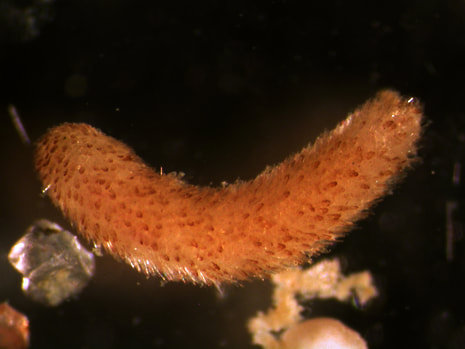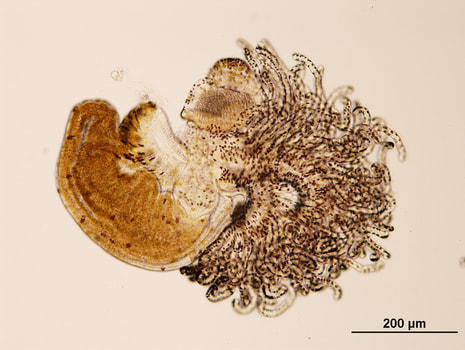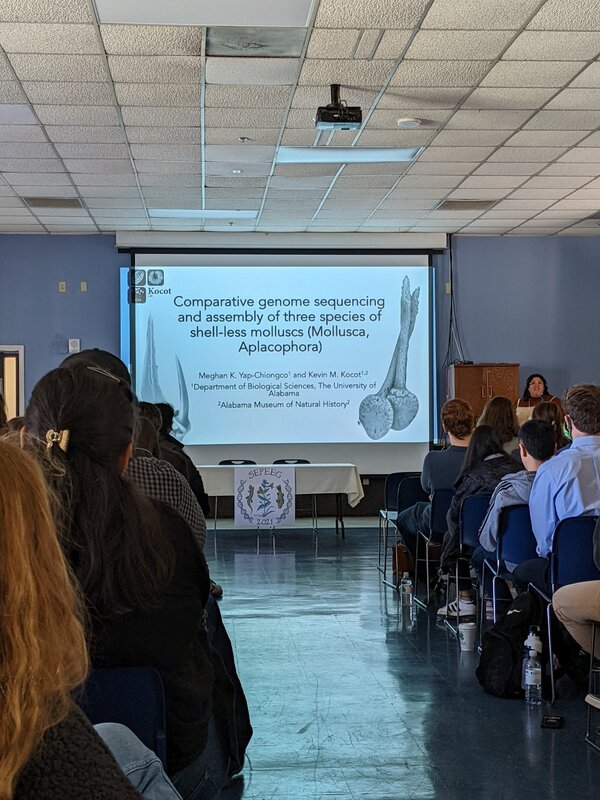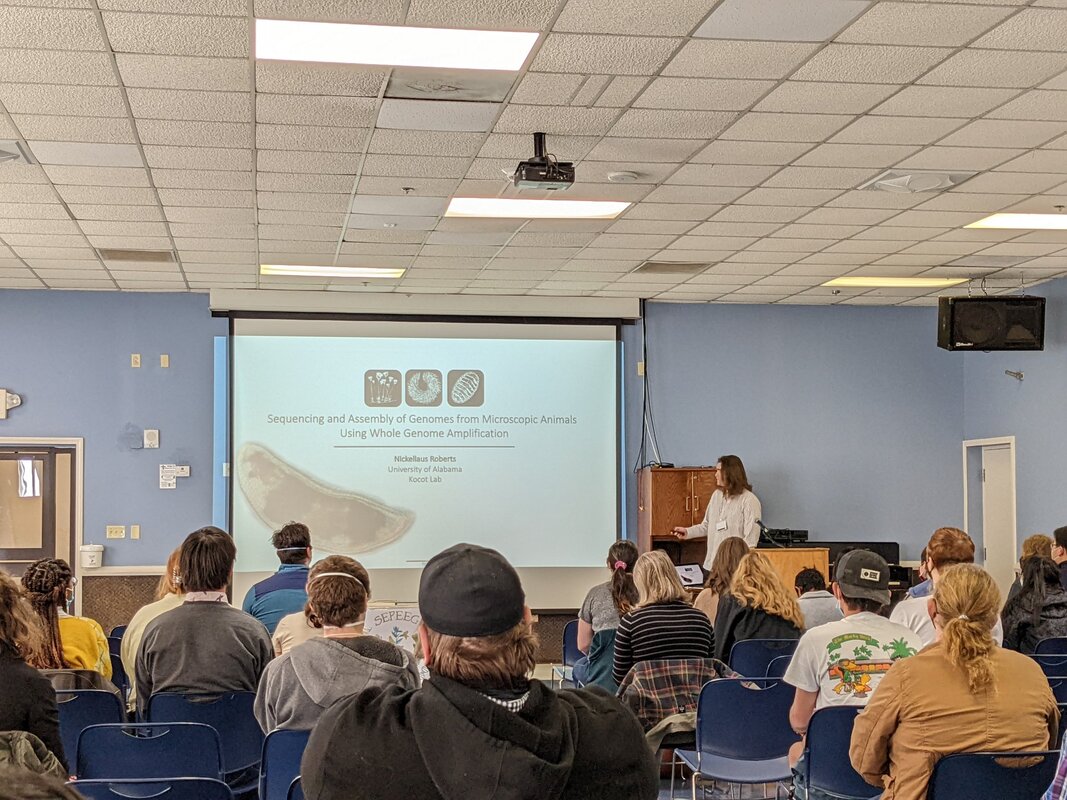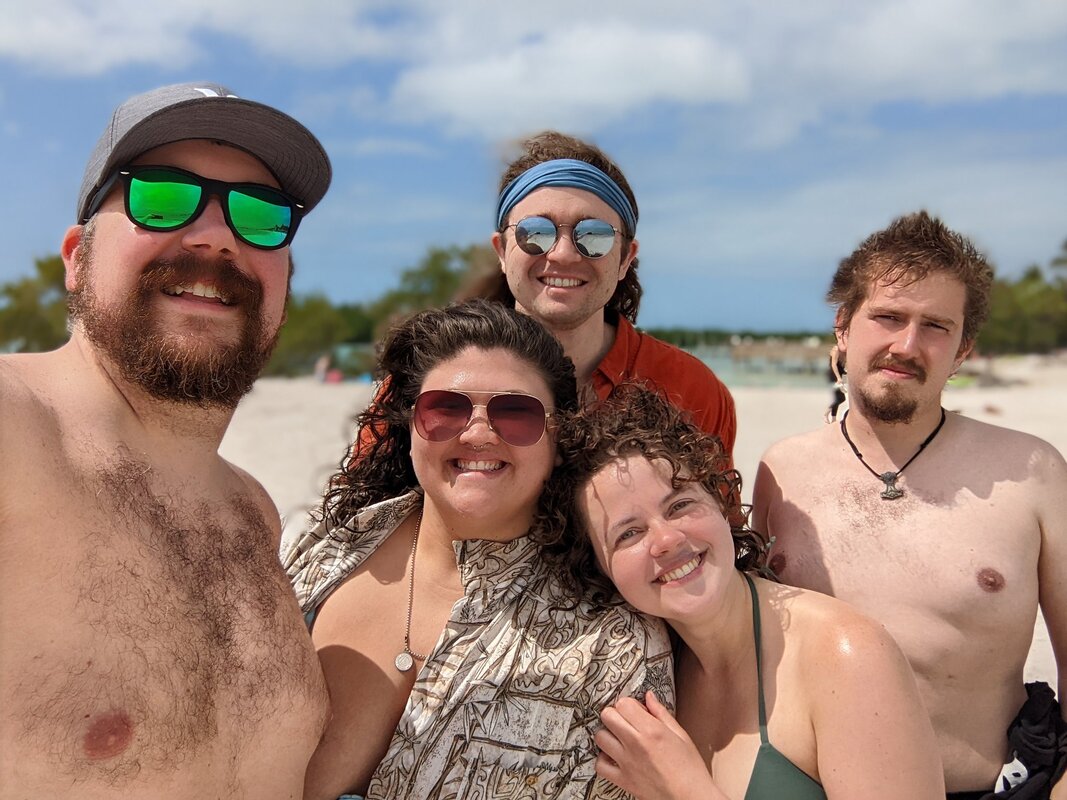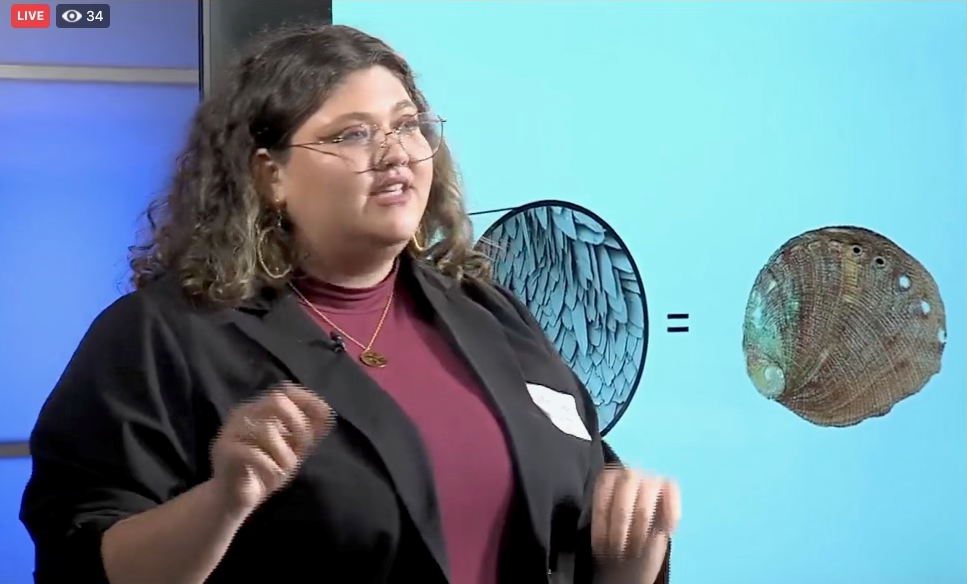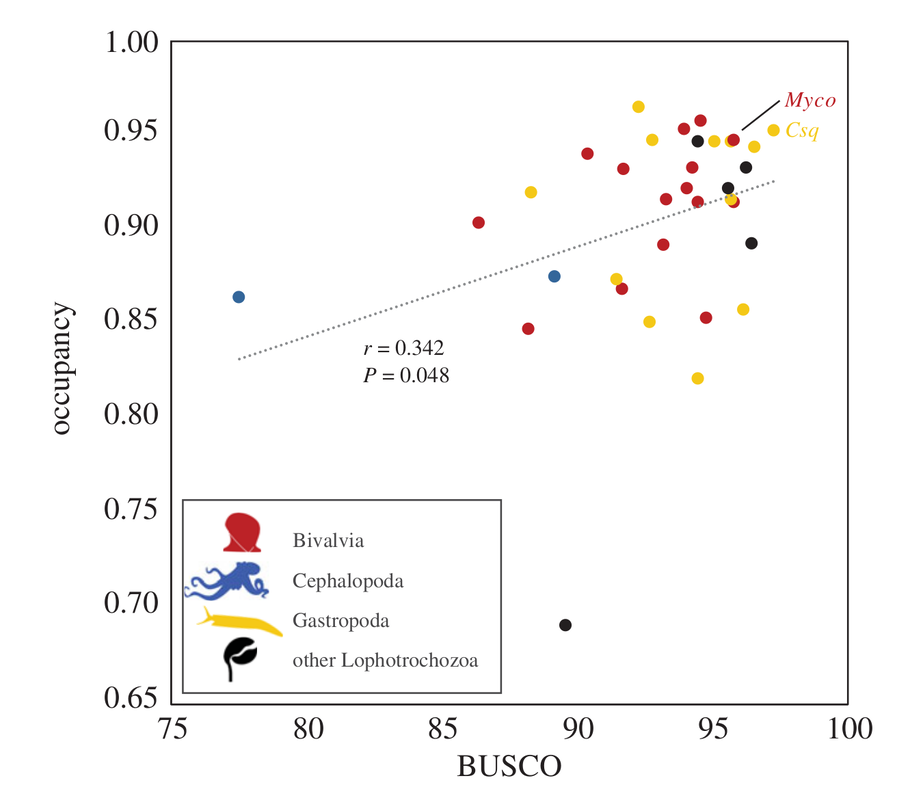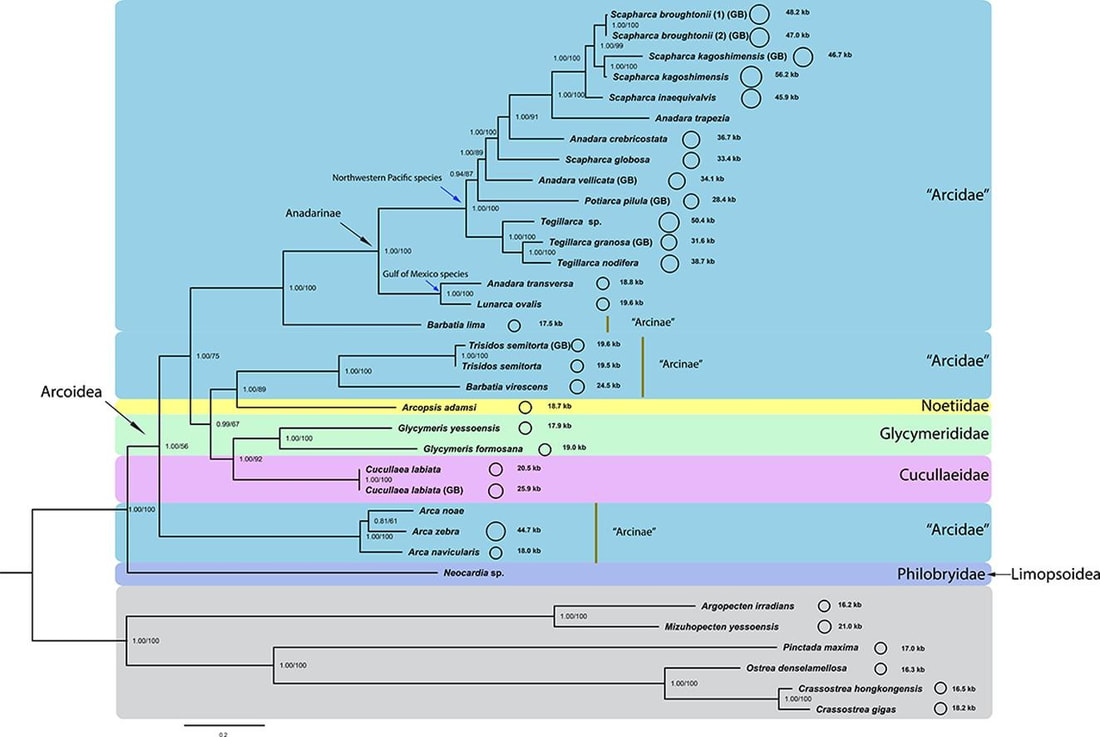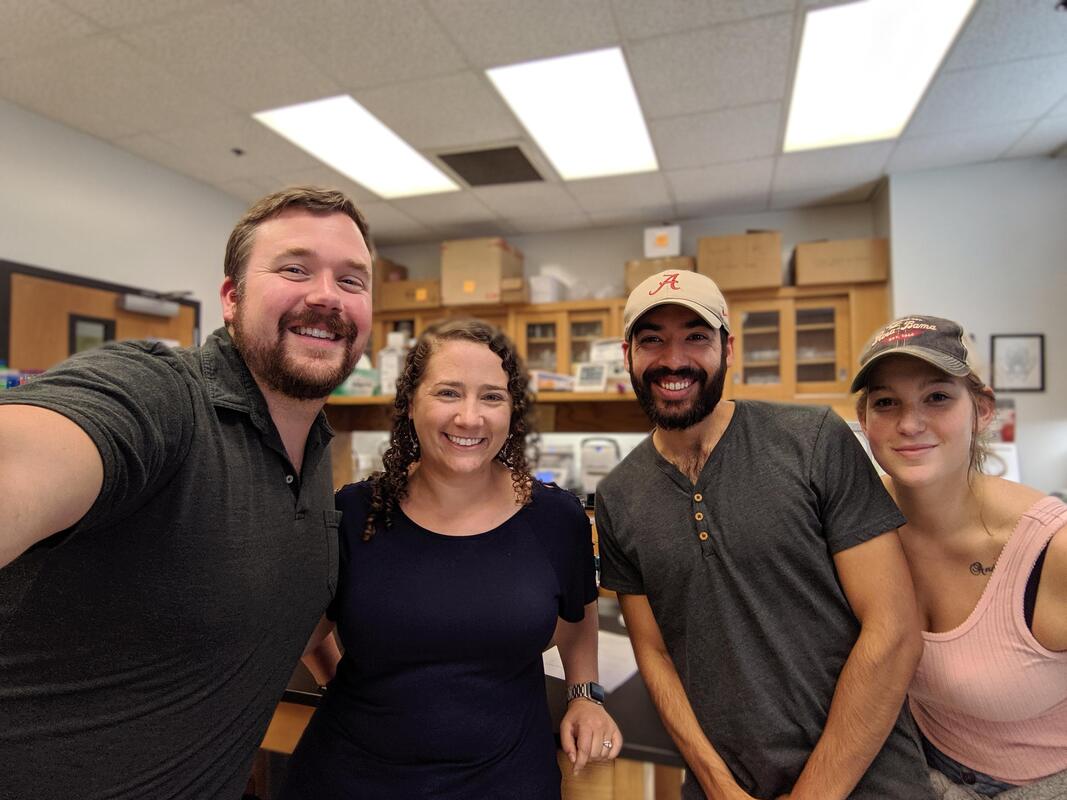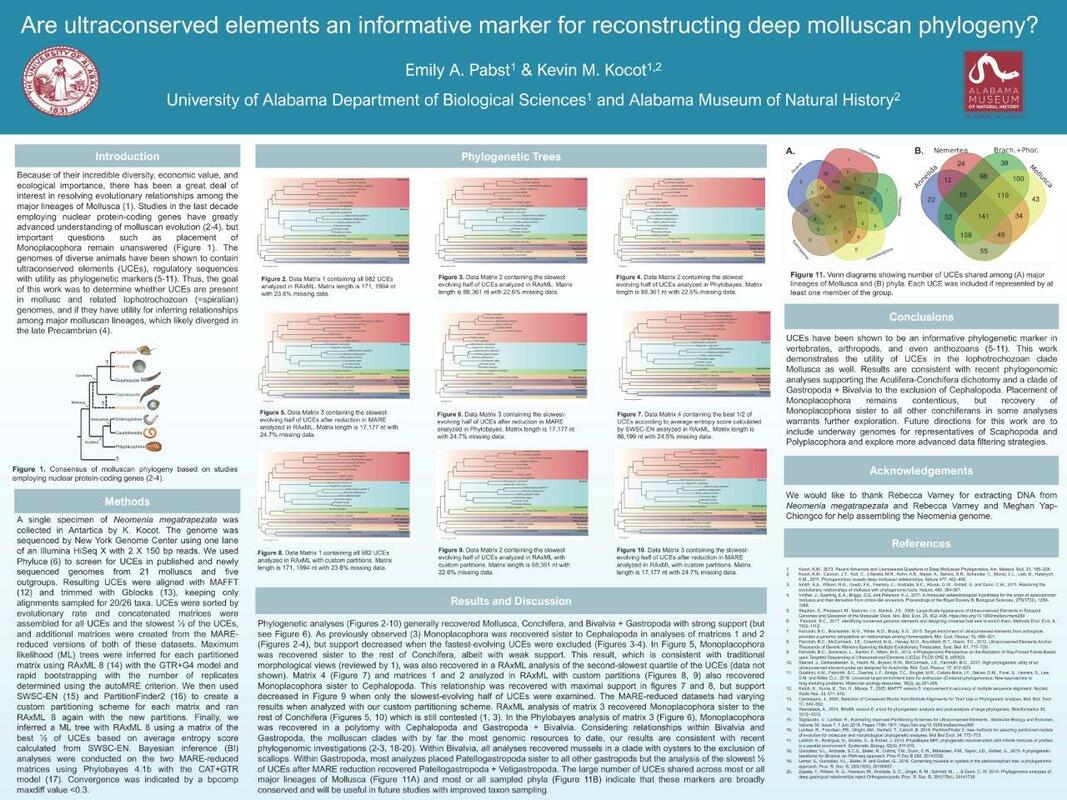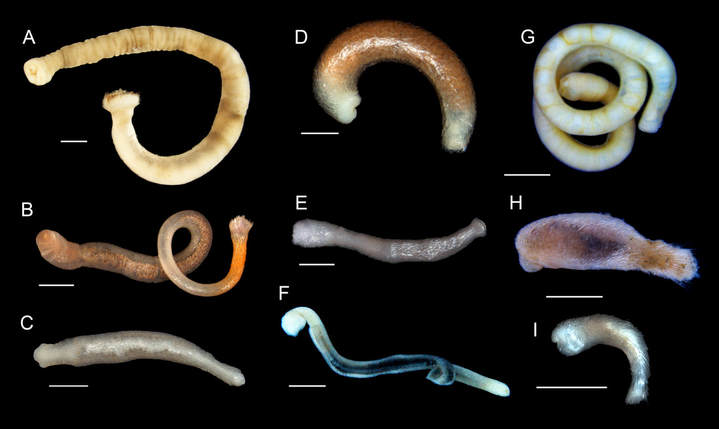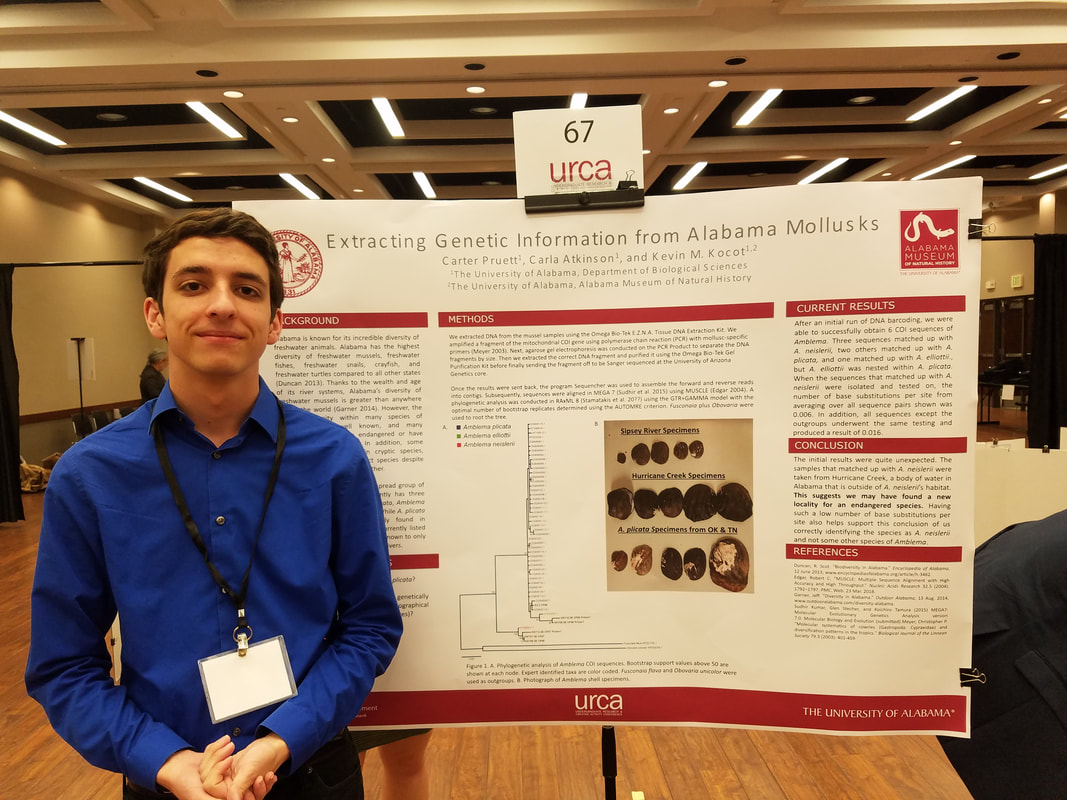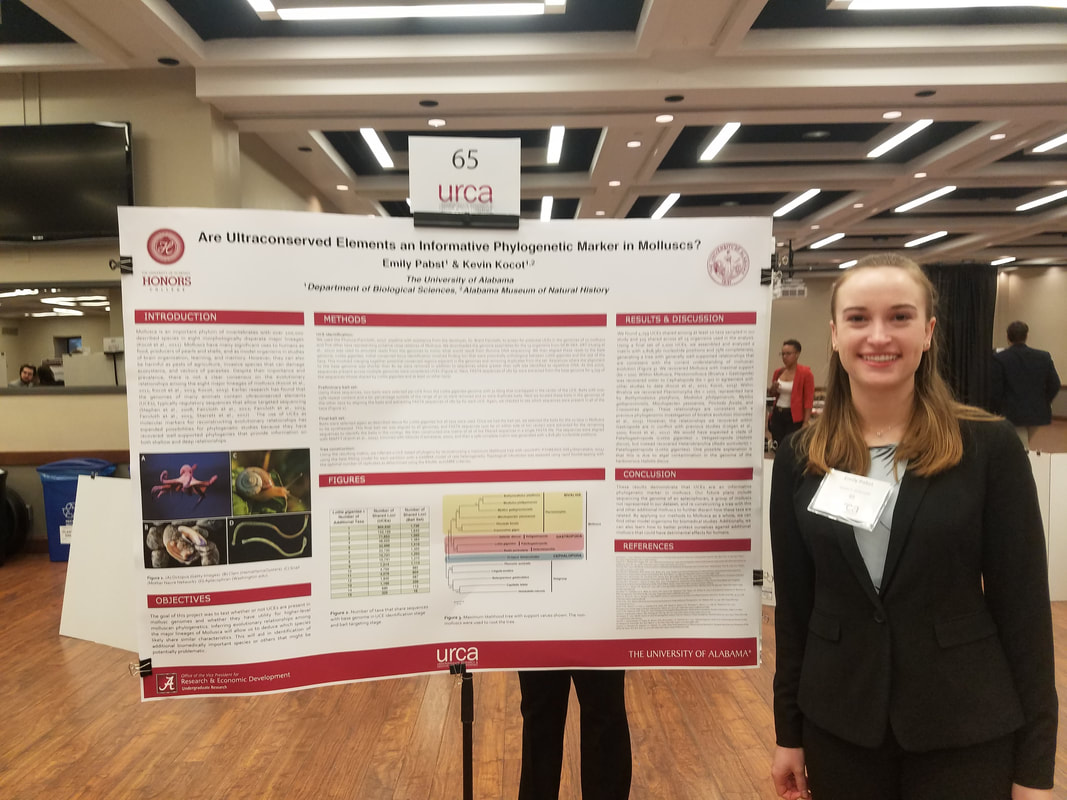|
The Kocot lab is part of the University of Alabama Department of Biological Sciences and the Alabama Museum of Natural History. Research in the lab focuses on the biodiversity, systematics, and genomics of understudied invertebrates using molecular and morphological approaches. We primarily study the worm-shaped aplacophoran molluscs, but we love invertebrates of all shapes and sizes.
The lab has ongoing projects addressing the systematics, population genetics, and genomics of diverse invertebrates. DNA barcoding is a routine application used in our biodiversity and population genetics studies. Our phylogenetic work primarily leverages high-throughput sequencing of transcriptomes and mitochondrial genomes. Increasingly, the lab is employing whole-genome sequencing to conduct comparative and evolutionary genomics studies, especially with respect to the evolution of biomineralization. Bioinformatic tools are essential to many of these activities and the lab routinely employs a variety of such approaches. In addition to molecular tools, our studies of invertebrate biodiversity and taxonomy employ traditional morphological tools like light and scanning electron microscopy and histology as well as cutting-edge morphological approaches such as high-resolution micro-computed tomography. We have a rich collection of deep sea molluscs and annelids from all over the world (especially Iceland, New Zealand, and Antarctica) just waiting for enthusiastic students. We feel that biodiversity research is essential to all aspects of the biological sciences as understanding the diversity of life on Earth is fundamental to all other questions about their biology. Likewise, phylogenetics is essential to all other biological disciplines as phylogeny is the framework by which all comparative biology is done. Finally, we value diversity, equity, and inclusion. In addition to a high standard of research quality, all lab members are expected to uphold a high standard of collegiality and integrity. |
Lab news
3 February, 2024
Members of the Kocot lab participated in Family Day at the Museum at the Alabama Museum of Natural History. Family Day at the Museum is a free event brought by the Alabama Museum of Natural History and The University of Alabama's Graduate School. This year's theme was Under the Sea! This campus and community-wide event will brought graduate departments together to showcase their content area through an interactive activity. We presented live meiofaunal animals, a 'build your own meiofaunal animal' activity, specimens of diverse other marine invertebrates, and videos of live Antarctic marine Invertebrates taken by Chandler Olson.
7 November 2023
Congratulations to Chandler Olson for passing his qualifying exams and proceeding to Ph.D. candidacy!
1-5 August, 2023
The 89th American Malacological Society meeting took place from 1-5 August 2023 in Tuscaloosa, Alabama at the University of Alabama and the Alabama Museum of Natural History. This meeting was organized by AMS President Kevin Kocot, members of the Kocot lab, the Atksinson lab, and others on campus. Given the incredible diversity of freshwater molluscs in Alabama, the topic of the President's Symposium (2 August) was “Freshwater Mollusk Diversity in a Biodiversity Hotspot.” This symposium was organized by Dr. Carla Atkinson (University of Alabama) and included a keynote talk by Dr. Dave Strayer (Cary Institute) and talks by Dr. Art Bogan (North Carolina Museum of Natural History), Dr. Alexa Maine (Confederated Tribes of the Umatilla Indian Reservation; CTUIR), Dr. Ellen Strong (Smithsonian Institution), Dr. Caryn Vaughn (University of Oklahoma), and Dr. Nathan Whelan (Auburn University and USFWS). Contributed oral presentations (3-4 August) and posters (evening of 2 August) spanned diverse sub-disciplines of malacology with work on molluscan genomics, phylogenetics, and freshwater molluscan ecology particularly well-represented. Student-centered events will include a student mixer at Black Warrior Brewing Company (after the poster session on 3 August) and a student-mentor networking program for in-person attendees (during lunch on 4 August). The meeting also included a panel discussion on inclusive fieldwork and field courses hosted by the Society’s Justice, Equity, Diversity, and Inclusion (JEDI) Committee (during lunch on 3 August). The annual AMS Auction (on 3 August) with auctioneer Paul Callomon was a hit and raised ca. $2,500 to support AMS student awards.
Congratulations to Meghan Yap-Chiongco who received a Best Student Presentation award for her talk "Tracing the Evolutionary Origins of Biomineralization: Insights from Two Aplacophoran Genomes!"
Congratulations to Meghan Yap-Chiongco who received a Best Student Presentation award for her talk "Tracing the Evolutionary Origins of Biomineralization: Insights from Two Aplacophoran Genomes!"
27 February - 5 May, 2023
Members of the Kocot lab participated in the NBP23-03 "IcyInverts" research cruise on the RVIB Nathaniel B. Palmer to sample marine invertebrates in the Eastern Antarctic. This was a highly successful cruise with highlights including sampling over 500 solenogasters (with as many as 50 new species!), two species of Monoplacophora, and two new species of Xenoturbella! Learn more about the cruise at the IcyInverts website and see our specimens in the Alabama Museum of Natural History collections on Arctos.
3-7 January, 2023
The Kocot lab graduate students attended the 2023 SICB meeting in Austin, TX. Emily presented on the huge and immensely useful aplacophoran barcoding dataset she has generated so far in her poster "A global DNA barcode library for Solenogastres (Mollusca, Aplacophora)" and Chandler presented on the impressive amount of work he's accomplished so far on the high diversity of Icelandic Solenogastres in his poster "Diversity of Solenogastres (Mollusca, Aplacophora) in Deep Icelandic Waters."
27 November to 13 December, 2022
Taking advantage of his sabbatical, Kevin traveled to Salalah, Oman and joined a Bioblitz led by Gustav Paulay at the University of Florida. The team sampled marine invertebrates intertidally and by diving and Kevin got some quality microscope time in to sample some incredible meiofauna. The divers made Kevin's year by sampling 8 specimens of the giant solenogaster aplacophoran mollusc Epimenia (arabica?). Note the beautiful blue polka dots!
1-12 August, 2022
This summer, Kocot lab members Franzi Bergmeier, Carmen Cobo, Jesús Martínez Sanjuán, and Meghan Yap-Chiongco attended the World Congress of Malacology (WCM) in Munich, Germany. Franzi was instrumental in the organization of this meeting and by all accounts it was outstanding. Big congratulations to Meghan Yap-Chiongco who won the American Malacological Society Best Student Talk award! After WCM, Carmen and Meghan met up with Nick Roberts in Vienna and they attended the 5th International Congress on Invertebrate Morphogy! Likewise it was an excellent meeting and everyone really enjoyed the exciting science and catching up with old friends! Big thanks to the organizers of both conferences who made them a huge success!
July - August 2022
In the second half of summer 2022, Kevin co-taught Biodiversity and Integrative Taxonomy of Invertebrates (BITI) at Friday Harbor Laboratories with Gustav Paluay (University of Florida). This course coverered methods for documenting and describing species-level diversity of invertebrate animals and applications of these methods in ecology, evolution, resource management, etc. Emphasis was placed on small and often overlooked taxa (e.g., meiofauna), but the content of the course was aimed to be broadly applicable to the study of diverse invertebrates.
13-24 June 2022
This June, Kevin co-organized the Smithsonian Marine Station Meiofauna Diversity and Taxonomy Workshop with Ashleigh Smythe (Virginia Military Institute). The goal of this course was to help train the next generation of marine invertebrate taxonomists on marine meiofauna, a vastly understudied size class of animals. We took a taxon survey approach and emphasized practical skills essential for the collection, identification, characterization, preservation, and molecular analysis of meiofauna. Sampling of diverse habitats near Fort Pierce (e.g., Capron Shoal and local beaches) and the Florida Keys (e.g., coral reefs, rubble fields, mangroves, and beaches) provided a wealth of specimens of diverse taxa for our investigations. Aside from Kevin and Ashleigh, Rick Hochberg (University of Massachusetts Lowell), Oleksandr Holovachov (Swedish Museum of Natural History), Ulf Jondelius (Swedish Museum of Natural History), Francesca Leasi (University of Tennessee Chattanooga), and Torsten Struck (University of Oslo Natural History Museum) were mentors who worked closely with students to train them in taxonomy of their groups of expertise during the two week workshop.
9 April 2022
The Kocot lab had a great time sharing our research and talking about crustaceans with attendees of the 2022 Bama Bug Fest! Follow @BamaBugFest on Twitter and check out coverage by Tuscaloosa News!
25-27 March 2022
Meghan Yap-Chiongco, Nick Roberts, and Kevin Kocot attended the SEPEEG Meeting and had a fantastic time at our first in-person meeting in a while. We got to meet amazing researchers from all over the Southeastern U.S. and Meghan and Nick gave excellent presntations!
12-19 March 2022
Members of the Kocot lab met up with Dr. Holly Bik's lab from the University of Georgia to sample meiofauna in the Florida Keys over spring break. It was a nice break from the grind and we found a lot of awesome animals!
15 November 2021
Double congratulations to Meghan Yap-Chiongco this month! Meghan was a University-wide finalist in the UA 3-Minute Thesis competition. This event was streamed live to the web and televised (see screen grab below left). Meghan also won the American Microscopical Society's microphotography contest in the black and white category with her photo of the solenogaster aplacophoran mollusc Macellomenia schanderi (below right).
14 October 2021
The Kocot lab presented at the UA Faculty Research Showcase to share our research with students on campus. We talked about the importance of natural history collections and why little and weird invertebrates are cool. Even Big Al got excited about meiofauna!
20 September 2021
|
Happy National Postdoc Appreciation Week! This week we are honoring Kocot lab postdoctoral researcher Dr. Carmen Cobo for all the big and little things she does to make the lab a great place to work!
Learn more about Carmen's research and other postdoctoral researchers at UA via @UaDeptBSC tweets this week with the hashtag #postdocappreciationweek |
18 August 2021
The Kocot lab is thrilled to welcome new Ph.D. student Chandler Olson! Chandler Joins us from Drexel University and has a lot of research experience already under his belt! Chandler will be studying the biodiversity and systematics of aplacophoran molluscs. Check out his website at www.seahorseandco.com.
11-31 May 2021
Dr. Carmen Cobo took part in the third expedition of the La Planète Revisiteé programme in Corsica (France). This set of expeditions, led by the Muséum National d'Histoire Naturelle, in collaboration with the Collectivité de Corse and the Office Français de la Biodiversité, aims to modernize the inventories of Mediterranean taxa by enriching them with digital images and taking tissue samples for DNA sequencing. The collection of benthic fauna was carried out by diving (visual collection, vacuuming, and brushing), dredging, and intertidal sampling. Carmen participated in some of the sampling activities, although her main mission was sorting the light fractions, where Aplacophora are more likely to be found. During the three expeditions carried out on this Mediterranean island around a hundred specimens of Aplacophora were found! The solenogasters (48 specimens), a loan from the Paris Museum, are now in our laboratory at the University of Alabama and under study.
9 April 2021
Three Kocot lab members were recognized with awards at this year's Biological Sciences! Congratulations all!
Holznagel Award in Biology – Rowan Batts, Caroline Bond
Grantland and Louise Rice Scholarship (Marine Science) – Rowan Batts
Award for graduate students performing research in marine sciences – Meghan Yap Chiongco
Holznagel Award in Biology – Rowan Batts, Caroline Bond
Grantland and Louise Rice Scholarship (Marine Science) – Rowan Batts
Award for graduate students performing research in marine sciences – Meghan Yap Chiongco
5 April 2021
New publication on benchmarking Oxford Nanopore genome assemblers for mollsucan genomics is out in Philosophical Transactions of the Royal Society B. This international collaboration with researchers in China, Japan, Germany, and the United States suggests that 40–50X coverage of nanopore long reads is sufficient for high-quality molluscan genomes. The genome assembler Flye (plus polishing with short PE reads) is likely a top choice for assembling relatively compact and only moderately heterozygous molluscan genomes, while NextDenovo may be advantageous for larger and more highly heterozygous molluscan genomes.
12 March 2021
Congratulations to Dr. Rebecca Varney who successfully defended her Ph.D. on the amazing iron-clad teeth of chitons! Rebecca will be joining Dr. Todd Oakley's lab at UCSB this summer where she will be working on the genomics of "sea fireflies" (Ostracoda).
18 February 2021
Congratulations to Dr. Carmen Cobo on her new publication in Zootaxa entitled "On the diversity of abyssal Dondersiidae (Mollusca: Aplacophora) with the description of a new genus, six new species, and a review of the family."
31 January 2021
AplacBase is live! Meghan Yap-Chiongco, Carmen Cobo, and Franzi Bergmeier (LMU Munich) assembled this resource for all things Aplacophora. Check it out for an up-to-date species database, a searchable map of type localities, a complete database of scientific literature dealing with aplacophorans, and ID guides to aid in the higher-level identification of aplacophorans. https://aplacbase.weebly.com
11 January 2021
The lab welcomes back Dr. M. Carmen Cobo as a postdoctoral researcher! Carmen joined the lab in 2019 as a Fulbright postdoctoral scholar but she is back as a postdoctoral researcher. Carmen will be studying the biodiversity and systematics of aplacophoran molluscs.
30 December 2020
Congratulations to Meghan Yap-Chiongco for being awarded the the Professional Development Award supported by the Broadening Participation Program at SICB. Meghan will present a poster entitled "Proteomic and Developmental Studies of Aplacophoran Sclerites to Study the Origins of Molluscan Mineralized Structures" at the SICB 2021 meeting.
18 December 2020
The IcyInverts cruise (NBP 20-10) has ended, but the science is really just getting started. Here's the abridged version of the Kocot team cruise report. The Kocot team of the IcyInverts cruise was funded through NSF DEB 1846174 (CAREER: Revolutionizing Biodiversity and Systematics Research on Aplacophora (Mollusca) and Training the Next Generation of Invertebrate Systematists). The main goal of the Kocot team was to collect aplacophoran mollusc specimens to support systematic research on this group. Originally, it was proposed to sample Argentinean waters and waters off the Antarctic peninsula but sampling localities off Argentina had to be dropped from this cruise as it would have necessitated the inclusion of an Argentinean observer, which would have negated the careful quarantine procedures implemented to protect cruise participants from COVID-19.
The Antarctic Peninsula is home to the most diverse aplacophoran fauna in the world. To date, 47 of the 73 described Antarctic solenogaster species have been collected from waters off the Antarctic Peninsula and around fifteen are described from the proposed sampling region off Argentina. Collection in these regions was proposed as it would significantly expand the diversity of aplacophorans sampled for this work at all taxonomic levels. Species from the proposed sampling areas represent 18 of the 28 aplacophoran families and all five orders.
Sampling was conducted via Blake trawl, epibenthic sled, box corer, and megacorer. During the course of the five weeks of sampling, 123 lots of Solenogastres were obtained, totaling 160 specimens. These specimens were collected from 21 different stations and 28 different sampling events. Over half of these lots were unique morphospecies, but a few morphospecies were found in high numbers. One of the most common Solenogastres species found was Dorymenia tricarinata with 9 specimens. Entonomenia was the most common genus collected with 41 specimens, and up to 7 different morphospecies could be discerned.
Every specimen was imaged using a Canon EOS Mark IV digital camera with a 100 mm or 65 mm macro lens. Sclerites were imaged using an Olympus BX 53 compound microscope with differential interference contrast. Generally, specimens of adequate size were fragmented to facilitate both morphological and molecular study. Specimens were relaxed and the anterior and posterior thirds of the body were fixed in either glutaraldehyde or formalin for histology back in the lab. This is important as internal anatomical characters must be studied in order to identify most species of Solenogastres. The midsection of the animal was cut – usually into multiple pieces – to be used for molecular work. If possible, tissue samples were put in RNAlater, cryo (flash frozen and stored at -80 °C), and 95% ethanol buffered with borax to maintain the integrity of the sclerites. For these three means of preservation, as little tissue was used as possible to maximize the amount of the animal used for morphology. For much smaller animals, this strategy of cutting the specimen was not always possible. In these cases, the anterior half was put in glutaraldehyde for morphological analysis, while the posterior half was put in buffered ethanol for molecular work.
In cases where more than two individuals were obtained from a site and were thought to be the same species, whole specimens were retained in buffered ethanol, glutaraldehyde, and/or formalin. In these cases, at least two specimens were preserved for molecular work and at least two were preserved for morphological work. Depending how many specimens were obtained and the condition they were found in, some samples had a combination of sectioning and whole organism preservation to achieve this.
Unexpectedly, specimens of Caudofoveata were collected from five different sampling localities, amounting to 9 total specimens. No caudofoveatates have been described from Antarctica. Most of these specimens were put into borax buffered 95% ethanol as (unlike solenogasters) examination of their internal anatomy is not generally needed for identification and taxonomy. External anatomical characteristics, sclerites, and molecular data will be relied upon to describe these new species. A few tissue samples were also preserved by freezing and in RNAlater for additional molecular analysis.
Although this cruise was highly successful in terms of numbers of individuals and species, the number of higher-level taxa that could be sampled was disappointing with only around seven families sampled. In particular, the quantity and diversity of small-bodied aplacophorans obtained was very low. This is likely due to the poor performance of the epibenthic sled. Although the coarsest mesh that would retain the desired organisms was used (500 micrometers), the available instrument tended to quickly fill with sediment or even rocks, suggesting that it was digging into the sediment rather than collecting the top-most layer as intended. Some modifications made by the extremely talented marine technicians such as reducing the scope of wired paid out to 2:1 rather than 3:1 and adding a ‘tickling chain’ helped improve the quality of the recovered samples, but the resulting sample required significant sieving and produced relatively few animals compared to mud collected by the Blake trawl that was sieved.
Additionally, three-hour time-lapse videos were taken of numerous specimens during the cruise. Initial videos were taken in containers with just seawater. After a Neomenia specimen was recorded exhibiting behavior suggesting that it was trying to dig, sediment was added, and subsequent videos were recorded with sediment in place. Neomenia, which has been known to be associated with sediment, had never been previously been recorded burrowing. Though Neomenia had the most discernable behavioral differences relative to other solenogasters recorded, there was interesting behavioral variation among the specimens recorded. Very little is known of the behavior of Aplacophora, so though this behavior was recorded in lab conditions rather than in their natural habitat and relatively few specimens were recorded, the analysis these data could prove to be valuable in our attempts to better understand these small, shell-less molluscs.
In the Kocot lab, we will use histology and microscopy to identify specimens collected during the cruise. DNA barcoding will be performed to help future non-experts identify specimens without the need for detailed knowledge of aplacophoran anatomy. Transcriptome and genome sequencing will be performed on select specimens for our phylogenomic investigations aimed at better understanding the evolutionary history of aplacophorans. Material from this cruise will also be employed in our studies of molluscan biomineralization and other projects beyond the scope of Kevin's CAREER grant.
The Antarctic Peninsula is home to the most diverse aplacophoran fauna in the world. To date, 47 of the 73 described Antarctic solenogaster species have been collected from waters off the Antarctic Peninsula and around fifteen are described from the proposed sampling region off Argentina. Collection in these regions was proposed as it would significantly expand the diversity of aplacophorans sampled for this work at all taxonomic levels. Species from the proposed sampling areas represent 18 of the 28 aplacophoran families and all five orders.
Sampling was conducted via Blake trawl, epibenthic sled, box corer, and megacorer. During the course of the five weeks of sampling, 123 lots of Solenogastres were obtained, totaling 160 specimens. These specimens were collected from 21 different stations and 28 different sampling events. Over half of these lots were unique morphospecies, but a few morphospecies were found in high numbers. One of the most common Solenogastres species found was Dorymenia tricarinata with 9 specimens. Entonomenia was the most common genus collected with 41 specimens, and up to 7 different morphospecies could be discerned.
Every specimen was imaged using a Canon EOS Mark IV digital camera with a 100 mm or 65 mm macro lens. Sclerites were imaged using an Olympus BX 53 compound microscope with differential interference contrast. Generally, specimens of adequate size were fragmented to facilitate both morphological and molecular study. Specimens were relaxed and the anterior and posterior thirds of the body were fixed in either glutaraldehyde or formalin for histology back in the lab. This is important as internal anatomical characters must be studied in order to identify most species of Solenogastres. The midsection of the animal was cut – usually into multiple pieces – to be used for molecular work. If possible, tissue samples were put in RNAlater, cryo (flash frozen and stored at -80 °C), and 95% ethanol buffered with borax to maintain the integrity of the sclerites. For these three means of preservation, as little tissue was used as possible to maximize the amount of the animal used for morphology. For much smaller animals, this strategy of cutting the specimen was not always possible. In these cases, the anterior half was put in glutaraldehyde for morphological analysis, while the posterior half was put in buffered ethanol for molecular work.
In cases where more than two individuals were obtained from a site and were thought to be the same species, whole specimens were retained in buffered ethanol, glutaraldehyde, and/or formalin. In these cases, at least two specimens were preserved for molecular work and at least two were preserved for morphological work. Depending how many specimens were obtained and the condition they were found in, some samples had a combination of sectioning and whole organism preservation to achieve this.
Unexpectedly, specimens of Caudofoveata were collected from five different sampling localities, amounting to 9 total specimens. No caudofoveatates have been described from Antarctica. Most of these specimens were put into borax buffered 95% ethanol as (unlike solenogasters) examination of their internal anatomy is not generally needed for identification and taxonomy. External anatomical characteristics, sclerites, and molecular data will be relied upon to describe these new species. A few tissue samples were also preserved by freezing and in RNAlater for additional molecular analysis.
Although this cruise was highly successful in terms of numbers of individuals and species, the number of higher-level taxa that could be sampled was disappointing with only around seven families sampled. In particular, the quantity and diversity of small-bodied aplacophorans obtained was very low. This is likely due to the poor performance of the epibenthic sled. Although the coarsest mesh that would retain the desired organisms was used (500 micrometers), the available instrument tended to quickly fill with sediment or even rocks, suggesting that it was digging into the sediment rather than collecting the top-most layer as intended. Some modifications made by the extremely talented marine technicians such as reducing the scope of wired paid out to 2:1 rather than 3:1 and adding a ‘tickling chain’ helped improve the quality of the recovered samples, but the resulting sample required significant sieving and produced relatively few animals compared to mud collected by the Blake trawl that was sieved.
Additionally, three-hour time-lapse videos were taken of numerous specimens during the cruise. Initial videos were taken in containers with just seawater. After a Neomenia specimen was recorded exhibiting behavior suggesting that it was trying to dig, sediment was added, and subsequent videos were recorded with sediment in place. Neomenia, which has been known to be associated with sediment, had never been previously been recorded burrowing. Though Neomenia had the most discernable behavioral differences relative to other solenogasters recorded, there was interesting behavioral variation among the specimens recorded. Very little is known of the behavior of Aplacophora, so though this behavior was recorded in lab conditions rather than in their natural habitat and relatively few specimens were recorded, the analysis these data could prove to be valuable in our attempts to better understand these small, shell-less molluscs.
In the Kocot lab, we will use histology and microscopy to identify specimens collected during the cruise. DNA barcoding will be performed to help future non-experts identify specimens without the need for detailed knowledge of aplacophoran anatomy. Transcriptome and genome sequencing will be performed on select specimens for our phylogenomic investigations aimed at better understanding the evolutionary history of aplacophorans. Material from this cruise will also be employed in our studies of molluscan biomineralization and other projects beyond the scope of Kevin's CAREER grant.
16 December 2020
Congratulations to Nick Roberts for receiving an honorable mention for their GIGA Fellowship in Invertebrate Genomics!
http://giga-cos.org/Wordpress/2020
http://giga-cos.org/Wordpress/2020
15 December 2020
Congratulations to Rebecca Varney for her new first-author publication "The iron-responsive genome of the chiton Acanthopleura granulata" in Genome Biology and Evolution. Chitons are an excellent system to study if you are interested in biomineralization - they make shells, sclerites, and a radula hardened with iron in the form of magnetite. Rebecca's work shed's light on the biomineralization toolkit used by chitons and shows how they are able to regulate the large amounts of iron needed to secrete their incredibly abrasion-resistant radula. This is the first aculiferan mollusc genome (i.e., the first from the clade that includes chitons and aplacophorans, which is the sister group to all other molluscs) and thus will be incredibly useful for future studies on virtually all aspects of molluscan biology.
18 October 2020
We're... still on a boat. Today the RVIB Nathaniel B. Palmer crosses the equator. We are still on track to get to Punta Arenas, Chile on Novemeber 2nd.
20 September 2020
We're on a boat! Kevin, Rebecca, Nick, and Emily will be conducting field work on the RVIB Nathaniel B. Palmer 20-10 cruise to the Bellinghausen Strait and Weddell Sea, Antarctica. They are joined by teammates Sarah Gerken (Professor in the Department of Biological Sciences at the University of Alaska, Anchorage) and and Will Ballentine (Ph.D. student in Kelly Dorgan's lab at the Dauphin Island Sea Lab / the University of South Alabama). We will primarily be sampling small macrofauna (especially aplacophorans and cumaceans) using an epibenthic sled in order to better understand the biodiversity and evolutionary history of these and other understudied taxa in Antarctica. We will be working closely with other teams on the ship led by Ken Halanych (Auburn University), Andy Mahon (Central Michigan University), and Deric Lerman (Central Michigan University).
Learn more about the project by visiting our website: www.icyinverts.com
Learn more about the project by visiting our website: www.icyinverts.com
10 September 2020
On 10 September, Rebecca Varney will co-lead a Spiraliabase virtual lab meeting on high molecular weight DNA extraction and RNA extraction with Vanessa Knutson. Visit Spiraliabase to register and see the recorded meeting after it is over.
19 August 2020
The Kocot lab is thrilled to be joined by Emily McLaughlin. Emily joins us from southern California where she studied feather stars in the lab of Greg Rouse at Scripps Institution of Oceanography. In the Kocot lab, Emily will to study aplacophoran mollusc biodiversity, taxonomy, and systematics. Welcome Emiliy!
23 June 2020
Congratulations to Rebecca Varney for winning the 2020 American Microscopical Society Best Student Presentation Competition for her poster "Localized physiological changes regulate the biomineralization of magnetite in the radula of the chiton Acanthopleura granulata" at the 2020 Society of Integrative and Comparative Biology meeting in Austin, TX!
23 June 2020
New pub on the phylogeny and giant mitochondrial genomes of Arcidae (Bivalvia) in Molecular Phylogenetics and Evolution.
https://www.sciencedirect.com/science/article/abs/pii/S1055790320301299
https://www.sciencedirect.com/science/article/abs/pii/S1055790320301299
10 June 2020
Congratulations to Maddie McCutcheon who successfully defended her M.S. thesis! Maddie has been studying solenogaster aplacophoran mollusc taxonomy and the phylogeny of aplacophoran class Caudofoveata. For her taxonomic work, Maddie has been focusing on the family Proneomeniidae from New Zealand where only three species of aplacophorans have been described. Her work will more than double this! For her phylogenetic work, Maddie has focused on the the caudofoveate Limifossor, which has been thought to be a phylogenetically important taxon but no molecular data were available to date. Her work supports the earlier suggestion that the family Limifossoridae is not monophyletic. Watch a recording of her thesis defense below.
28 May 2020
Kevin gave a talk on his NSF-funded CAREER project on aplacophoran mollusc biodiversity for the Meiolive seminar series organized by Jeroen Ingels and Giovanni Santos. Check out the recording of the talk below and sign up for future talks by checking out @IAMeiofauna on Twitter!
22 May 2020
New pre-print! Kocot lab Ph.D. student Rebecca Varney sequenced the genome of the chiton Acanthopleura granulata and investigated the evolution of molluscan biomineralization with emphasis on the iron-strengthened radula of this remarkable species.
https://www.biorxiv.org/content/10.1101/2020.05.19.102897v1
https://www.biorxiv.org/content/10.1101/2020.05.19.102897v1
14 May 2020
Kevin and Vanessa González led a Spiraliabase.org virtual lab meeting on genome assembly and annotation. This is a broad overview of the topic that covers current best practices and some of the most popular tools used. Watch a recording on Vimeo.
30 March 2020
Congratulations to Nick Roberts who received an honorable mention on their NSF Graduate Research Fellowship Program application! NSF accords Honorable Mention to meritorious applicants who do not receive Fellowship awards. This is considered a significant national academic achievement. Although Nick did not receive a monetary award, they are granted access to the XSEDE high-performance computing cluster, which should be super useful in Nick's phylogenomics work. Congratulations!
14 February 2020
Meghan Yap-Chiongco was awarded a UA Museums Bishop-Stackman Scholarship to support her field work in Norway this summer. Congratulations Meghan!
13 February 2020
The Optical Analysis Facility has a shiny new (gently used) microtome all decked out for semi-thin histology! This hand-me-down from Dr. Martha Powell will be loved dearly.
16 January 2020
Rebecca Varney was awarded a UA Graduate Council Fellowship for the 2020/21 academic year! Congratulations Rebecca!
9 January 2020
The lab has a new paper in Scientific Reports on deep molluscan phylogeny. We carefully curated a high-quality data matrix and conducted phylogenomic analyses with broad taxon sampling including newly sequenced genomic data from the monoplacophoran Laevipilina antarctica. Whereas a partitioned maximum likelihood (ML) analysis using site-homogeneous models recovered Monoplacophora sister to Cephalopoda with moderate support, both ML and Bayesian inference (BI) analyses using mixture models recovered Monoplacophora sister to all other conchiferans with strong support. A supertree approach also recovered Monoplacophora as the sister taxon of a clade composed of the rest of Conchifera. Gastropoda was recovered as the sister taxon of Scaphopoda in most analyses, which was strongly supported when mixture models were used. Check out this open access paper in Scientific Reports.
3-7 January 2020
The Kocot lab divided an conquered two scientific meetings this January. Nick Roberts attended the Society of Systematic Biologists Systematics in the Swamp meeting in Gainsville, FL and Maddie, Meghan, Rebecca, and Kevin attended the Society of Integrative and Comparative Biology meeting in Austin, TX. I'm super proud of my awesome students who nailed their presentations!
6 December 2019
Congratulations to Kocot lab undergraduate researcher Elizabeth Batts who presented her research on aplacophoran mollusc biodiversity as part of the Randal Research Scholars Live series. A recording of her excellent presentation is linked to below.
12 October 2019
Congratulations to Meghan Yap-Chiongco for winning Best Poster at the 2019 Southeastern Ecology and Evolution Conference in Auburn, AL! Meghan's dissertation research is focused on biomineralization in Mollusca. Most studies on molluscan biomineralized structures have focused on conchiferan (e.g., snail or bivalve) shells. Aplacophorans are from the other branch of the molluscan tree and unlike most other molluscs, they lack shells. Instead aplacophorans are covered in a flexible coat of armor made of calcareous scales or spines called sclerites. Meghan is using genomics, transcriptomics, proteomics, and gene expression experiments to understand how aplacophoran sclerites are formed, if they are formed using homologs of genes used in shell formation in other molluscs, and what the ancestral molluscan biomineralization toolkit looked like.
14 August 2019
I'm ecstatic to share that my NSF CAREER proposal was funded! This $1.2M project will address the biodiversity, systematics, and genomics of aplacophorans. I will also organize several meiofauna taxonomy training workshops and my lab will have 2 cruises in Antarctica. To learn more about the project, check out the NSF website and read a press release from UA News.
12-16 August 2019
The Kocot lab had a great showing at the World Congress of Malacology in Pacific Grove, CA. Everyone presented and Rebecca Varney won an award for best student talk!!
3-8 August 2019
The Kocot lab conducted had a lab retreat and sampled meiofauna with Kelly Dorgan's lab at the Dauphin Island Sea Lab. Joining the group was new Kocot lab Ph.D. student Nick Roberts. Welcome Nick!!
3 June 2019 - 10 August 2019
The Kocot Lab welcomes Eric Breslau, a visiting M.S. student from Angel Valdés's lab at Cal. Poly. Pomona. Eric is working on phylogenomics of sea slugs and undertook a side project on tunicates while in the Kocot lab.
13 June 2019
New Kocot lab paper on higher-level nematode phylogeny led by Ashleigh Smythe (Virginia Military Institute) and co-authored by Oleksandr Holovachov (Swedism Museum of Natural History). We supplemented publicly available data (mostly from parasites) with transcriptomes from un-/under-dersampled free-living nematode clades and outgroups and conducted a phylum-wide phylogenomic analysis with a total of 108 nematodes. We recovered Enoplia as the sister taxon to the rest of Nematoda and identified a lot of targets for future taxon sampling to get a better handle on important aspects of nematode evolution (e.g., number of times parasitism evolved). Check it out in BMC Evolutionary Biology.
12 June 2019
The lab has a new paper in Nature on the origin of animal multicellularity led by Shunsuke Sogabe and Will Hatleberg, recent PhD graduates of the Degnan lab at The University of Queensland. We compared sponge cell type transcriptomes to those of unicellular holozoans including choanoflagellates. "Unexpectedly, we find that the transcriptome of sponge choanocytes is the least similar to the transcriptomes of choanoflagellates and is significantly enriched in genes unique to either animals or sponges alone." Read more about this study study at UA News, UQ News, and Science Alert.
Sogabe, S., Hatleberg, W., Kocot, K., Say, T., Stoupin, D., Roper, K., Fernandez-Valverde, S., Degnan, S. and Degnan, B., In press. Pluripotency and the origin of animal multicellularity. Nature s41586-019-1290-4.
Sogabe, S., Hatleberg, W., Kocot, K., Say, T., Stoupin, D., Roper, K., Fernandez-Valverde, S., Degnan, S. and Degnan, B., In press. Pluripotency and the origin of animal multicellularity. Nature s41586-019-1290-4.
8 April 2019
New paper on aplacophoran phylogeny and description of a bizarre new solenogaster! Dr. Kocot and his collaborators at Auburn University, the University of Bergen, and Rådgivende Biologer in Bergen published a new study in Proceedings of the Royal Society B that begins to shed light on this poorly-known group. They sequenced transcriptomes from representatives spanning the diversity of the group and produced a broadly sampled evolutionary framework. Further, they describe a bizarre new species that lacks a radula (toothed tongue-like organ), foot, and mantle cavity – all the traditional hallmarks of the phylum Mollusca. The results of this study show that aplacophoran taxonomy requires revision as several traditionally recognized groups were not recovered and reveal a surprising degree of plasticity in the aplacophoran body plan. Read a press release about the paper by UA News.
12 April 2019
Undergraduate researchers Emily Pabst, Ryan Partiain, and Carter Pruett presented at the UA Arts and Sciences Summit for Undergraduate Research, Scholarship, and Creative Activity (URSCA). Congratulations to Ryan Partain for winning 2nd place for his poster!
2 April 2019
Congratulations to Kocot lab undergraduate researcher Emily Pabst for winning a Randall Research Award for her work on molluscan ultraconserved elements (UCEs)!
27 March 2019
Emily Pabst and Carter Pruett presented their research at the Undergraduate Research and Creative Activity (URCA) conference (and did a great job!). Click on the photos to check out their research.
3-7 January 2019
SICB is a fantastic meeting! Kevin and Rebecca participated in the "Best practices for using NGS-based datasets to determine statistically robust evidence of positive selection and convergent evolution of polar organisms" workshop to investigate adaptations of aculiferan molluscs to polar habitats. Rebecca presented a poster on the in-progress genome of the chiton Acanthopleura granulata and Kevin presented undergraduate researcher Emily Pabst's work on using UCEs to investigate deep molluscan phylogeny. Meghan and Maddie are looking forward to presenting their work next year!
3 December 2018
New publication on brittle star evolution and mitogenomics (online early):
Galaska, M.P., Li, Y., Kocot, K.M., Mahon, A.R. and Halanych, K.M., 2019. Conservation of mitochondrial genome arrangements in brittle stars (Echinodermata, Ophiuroidea). Molecular Phylogenetics and Evolution. 130:115-120.
Galaska, M.P., Li, Y., Kocot, K.M., Mahon, A.R. and Halanych, K.M., 2019. Conservation of mitochondrial genome arrangements in brittle stars (Echinodermata, Ophiuroidea). Molecular Phylogenetics and Evolution. 130:115-120.
30 November 2018
The Kocot lab hosted two visiting high school students as part of the Scientist for a Day program. Students participating in this program spend the day working in the lab learning real-world research skills and see what kinds work scientists do on a day-to-day basis. Eve and Mason spent the day imaging aplacophoran molluscs using SEM and preparing specimens for DNA extraction. We had nine students in attendance, representing five West Alabama high schools.
23 November 2018
New publication on pterobranch hemichordates showing a novel, lineage-specific genetic:
Li, Y., Kocot, K.M., Tassia, M.G., Cannon, J.T., Bernt, M. and Halanych, K.M., 2018. Mitogenomics reveals a novel genetic code in Hemichordata. Genome Biology and Evolution. In press.
Li, Y., Kocot, K.M., Tassia, M.G., Cannon, J.T., Bernt, M. and Halanych, K.M., 2018. Mitogenomics reveals a novel genetic code in Hemichordata. Genome Biology and Evolution. In press.
10 November 2018
New publication on caudofoveate aplacophoran mollusc phylogeny:
Mikkelsen, N.T., Todt, C., Kocot, K.M., Halanych, K.M. and Willassen, E., 2018. Molecular phylogeny of Caudofoveata (Mollusca) challenges traditional views. Molecular Phylogenetics and Evolution. In press.
Mikkelsen, N.T., Todt, C., Kocot, K.M., Halanych, K.M. and Willassen, E., 2018. Molecular phylogeny of Caudofoveata (Mollusca) challenges traditional views. Molecular Phylogenetics and Evolution. In press.
18-30 October
From 18-21 October, Kevin and Rebecca attended the Global Invertebrate Genomics Alliance (GIGA) III meeting in Curacao. This was an exciting meeting with excellent talks and posters by world experts in the field as well as some very savvy students. There are a lot of exciting advances in the field of invertebrate genomics in the pipe. After the meeting, we spent a week at CARMABI Research Station to sample meiofauna and chitons from all over the island. We even got interviewed by CoralLive about our research on meiofauna (tiny animals that live between grains of sand). Check it out on YouTube.
13 September 2018
Each year, the College of Arts and Sciences has a tent on the quad during the pre-homecoming football game festivities. As always, Biological Sciences (including the Kocot Lab) was there this year to share our research with students and the public.
28 September 2018
Rebecca presented her preliminary results on the genome of the chiton Acanthopleura granulata and the genomic basis of iron biomineralization at the 2018 UA DBS BioFest. Bonus coolness points: Rebecca had a chiton radula stuck to her poster via a magnet, which really gets the point across that there is a LOT of magnetite in these teeth!
22 August, 2018
The Kocot lab welcomes new M.S. student Maddie McCutcheon and new Ph.D. student Meghan Yap-Chiongco! Both have already hit the ground running with their work on aplacophoran molluscs.
20-31 August, 2018
Kevin participated in the Smithsonian Tropical Research Institute Taxonomy and Biology of Nemerteans workshop taught by Drs. Svetlana Maslakova and Megan Schwartz. If you don't think worms can be beautiful, you haven't seen enough nemerteans.
12-18 August, 2018
Kevin participated in the IceAGE workshop in Sandgerði, Iceland to help process fresh deep-sea samples from the IceAGE Reykjanes Ridge cruise and collaborate on deep-sea Icelandic invertebrate research.
8 August 2019
Do you like our lab clock? Made by Rebecca Varney.
1 August 2018
New publication on heterobranch phylogeny with Kocot lab undergraduate researcher Emily Pabst as first author:
Pabst, E.A. and Kocot, K.M., 2018. Phylogenomics confirms monophyly of Nudipleura (Gastropoda: Heterobranchia). Journal of Molluscan Studies. 84(3): 259–265,
Pabst, E.A. and Kocot, K.M., 2018. Phylogenomics confirms monophyly of Nudipleura (Gastropoda: Heterobranchia). Journal of Molluscan Studies. 84(3): 259–265,
10 June - 14 July, 2018
In 2007, Kevin took Marine Invertebrate Zoology a Friday Harbor Labs with fellow Halanych lab member Johanna Cannon (now at University of California Santa Barbara). This year they returned 11 years later to teach the course. This course is designed to provide students with comprehensive exposure to the subject of invertebrate zoology. Students learn about the diversity, taxonomy, ecology, evolution, structure, and function of invertebrates. We cover all animal phyla from Annelida to Xenoturbellida and explore diversity within phyla based on available exemplars. Students learn about the field of invertebrate zoology in light of information gained through the use of traditional tools like electron microscopy and histology as well as new tools like genomics and evolutionary developmental biology (“evo-devo”).
20-31 May, 2018
In late May, Kevin and Rebecca conducted field work at the Smithsonian Marine Station in Fort Pierce, FL with collaborator Ashleigh Smythe (Virginia Military College). We collected chitons for Rebecca's work and found an incredible diversity of meiofauna in samples collected by Higgins dredge and diving in the Florida Keys.
6 April, 2018
Congratulations (again!) to Kocot Lab undergraduate student Josh Goble for being awarded the Grant and and Louise Rice Scholarship and to Rebecca Varney for being awarded the Chair’s Scholarship for Outstanding Contribution for Teaching by a Graduate Student in Biological Sciences!
5 April, 2018
Congratulations to Kocot Lab undergraduate student Josh Goble who won first place at the The University of Alabama Undergraduate Research & Creative Activity Conference in the Life Sciences, Physical Sciences, Mathematics, and Water Division for his poster on "The Biodiversity of Deep-Sea Icelandic Aplacophoran Molluscs"
Here's a link to the poster itself:
https://www.kocotlab.com/uploads/7/4/8/7/74870527/goble_and_kocot_urca_2018_poster.pdf
Here's a link to the poster itself:
https://www.kocotlab.com/uploads/7/4/8/7/74870527/goble_and_kocot_urca_2018_poster.pdf
29 March, 2018
The Kocot lab had five student presenters at the 2018 UA Undergraduate Research and Creative Activity conference. Click on each picture to see the full poster as a PDF.
3-7 January, 2018
The Kocot lab had a good showing at SICB 2018.
• Kevin and Rebecca participated in the "Best practices for using NGS-based datasets to determine statistically robust evidence of positive selection and convergent evolution of polar organisms" workshop and are excited to see what makes polar aplacophoran molluscs tick
• Kevin co-organized a symposium entitled "From Small and Squishy to Big and Armored: Genomic, Ecological and Paleontological Insights into the Early Evolution of Animals" with Erik Sperling and by all accounts it was a hit!
• Kevin presented a poster on tunicate phylogeny
• Rebecca presented a poster with preliminary data on the genome of the chiton Acanthopleura granulata
• Kevin won the American Microscopical Society Ralph and Mildred Buchsbaum Prize for Excellence in Photomicrography for the photo below.
• Kevin and Rebecca participated in the "Best practices for using NGS-based datasets to determine statistically robust evidence of positive selection and convergent evolution of polar organisms" workshop and are excited to see what makes polar aplacophoran molluscs tick
• Kevin co-organized a symposium entitled "From Small and Squishy to Big and Armored: Genomic, Ecological and Paleontological Insights into the Early Evolution of Animals" with Erik Sperling and by all accounts it was a hit!
• Kevin presented a poster on tunicate phylogeny
• Rebecca presented a poster with preliminary data on the genome of the chiton Acanthopleura granulata
• Kevin won the American Microscopical Society Ralph and Mildred Buchsbaum Prize for Excellence in Photomicrography for the photo below.
7 December, 2017
Do molluscs and other lophotrochozoans have ultraconserved elements (UCEs)? Kocot lab member Emily Pabst screened publicly available lophotrochozoan genomes and, in her UA CBH live talk, which streamed live to the web today at noon (CST) showed that they have heaps! http://live.cbhp.ua.edu
10 October, 2017
New publication on ctenophore phylogeny:
Whelan, Nathan V., Kevin M. Kocot, Tatiana P. Moroz, Krishanu Mukherjee, Peter Williams, Gustav Paulay, Leonid L. Moroz, and Kenneth M. Halanych. 2017. Ctenophore relationships and their placement as the sister group to all other animals. Nature Ecology & Evolution: 1: 1737–1746.
Whelan, Nathan V., Kevin M. Kocot, Tatiana P. Moroz, Krishanu Mukherjee, Peter Williams, Gustav Paulay, Leonid L. Moroz, and Kenneth M. Halanych. 2017. Ctenophore relationships and their placement as the sister group to all other animals. Nature Ecology & Evolution: 1: 1737–1746.
July-August, 2017
• It's been a busy summer with lots of exciting field work
• Rebecca took the Marine Invertebrate Zoology course at FHL and collected chitons to study how their radulae form
• Then she headed down to the Florida Keys to collect Acanthopleura granulata, our budding lab model species
• Meanwhile, Kevin visited Leslie Harris and tagged along with the LACSD to collect caudofoveates
• Kevin is currently sampling meiofaunal aplacophorans and other critters at the Smithsonian Marine Station
• Rebecca took the Marine Invertebrate Zoology course at FHL and collected chitons to study how their radulae form
• Then she headed down to the Florida Keys to collect Acanthopleura granulata, our budding lab model species
• Meanwhile, Kevin visited Leslie Harris and tagged along with the LACSD to collect caudofoveates
• Kevin is currently sampling meiofaunal aplacophorans and other critters at the Smithsonian Marine Station
1 May, 2017
• The Kocot lab has a shiny new Phenom Pro table-top scanning electron microscope!
• This instrument allows one to image specimens at up to 130,000X
• Because it uses a low accelerating voltage (5 kV), specimens aren't 'fried' by the electron beam very quickly
• We can get ultrastructure and genomic data from the same specimen!
• This instrument allows one to image specimens at up to 130,000X
• Because it uses a low accelerating voltage (5 kV), specimens aren't 'fried' by the electron beam very quickly
• We can get ultrastructure and genomic data from the same specimen!
10 April, 2017
Emily Pabst received an honorable mention for her poster at the 2017 University of Alabama URCA Conference!
5 April, 2017
• The crown-of-thorns sea star genome is out in Nature!
• Link to the paper: Hall, Kocot, and Baughman et al. 2017 Nature doi:10.1038/nature22033
• Read press releases about it by BBC News, The Australian and The University of Alabama
• Link to the paper: Hall, Kocot, and Baughman et al. 2017 Nature doi:10.1038/nature22033
• Read press releases about it by BBC News, The Australian and The University of Alabama
1 April, 2017
New paper: Halanych, K.M. and K.M. Kocot. Genome Evolution: Shellfish Genes. Nature Ecology and Evolution.
11 January, 2017
Rebecca Varney joins the Kocot Lab as a Ph.D. student!
25 July - 8 August, 2016
• Kevin participated in the UNOLS Chief Scientist Training Program
• We used the human-occupied vehicle Alvin and the autonomous robot Sentry to study NW Atlantic deep-sea canyons and hydrocarbon seeps
• Check out this outreach event with the American Museum of Natural history that I participated in
• We used the human-occupied vehicle Alvin and the autonomous robot Sentry to study NW Atlantic deep-sea canyons and hydrocarbon seeps
• Check out this outreach event with the American Museum of Natural history that I participated in
13 June - 16 July, 2016
• Kevin taught Marine Invertebrate Zoology at The University of Washington Friday Harbor Labs with Megan Schwartz
• An awesome bunch of students and tons of awesome invertebrates!
• An awesome bunch of students and tons of awesome invertebrates!
23 March, 2016
• The lab actually has the stuff needed to do lab work now
• Kevin labels *everything*
• If only there were some students in the lab...
• Kevin labels *everything*
• If only there were some students in the lab...
23 February, 2016
• Kocot lab acquires two Dell PowerEdge workstations
• Each has 32 threads and 64 GB of RAM
• Kevin installs Linux and geeks out
• Each has 32 threads and 64 GB of RAM
• Kevin installs Linux and geeks out
16 February, 2016
• Kevin arrives in Tuscaloosa
• Process of setting up the lab commences
• Process of setting up the lab commences
1 January, 2016
• The Kocot lab officially exists!
• ...but Kevin was still in Antarctica on R/V Polarstern
• ...but Kevin was still in Antarctica on R/V Polarstern
|
The University of Alabama is committed to providing an inclusive environment that is free from harassment or discrimination based on race, genetic information, color, religion, ethnicity, national origin, socioeconomic status, political beliefs, sex, sexual orientation, gender expression, gender identity, age, ability, size, or veteran status.
|
The views, opinions, and conclusions expressed in this page are those of the author and not necessarily those of The University of Alabama or its officers and trustees. The content of this page has not been reviewed or approved by the University of Alabama, and the author is solely responsible for its content.


